
Metaverse and what it could mean for the Music industry
“The Metaverse”. That’s the thing you’ve probably been hearing about the last couple of months. You also probably heard it for the first time when Facebook announced that they were rebranding their parent company as Meta. But that surely brought up more questions than answers. Is it something that will replace the internet? Is it a place we’re supposed to start living in? Or does it have something to do with NFTs? Well, my friends, at least one thing about it is for sure–it is something quite tough to explain.
Neal Stephenson coined the term “metaverse” in his 90’s novel Snow Crash. In the piece, he described the metaverse as a 3D virtual world inhabited by avatars of real people. But science fiction stories can depict a vivid picture of the metaverse without ever really explaining how it should work or why it should exist.
To quote a recent Facebook statement, “The metaverse isn’t a single product one company can build alone. Just like the internet, the metaverse exists whether Facebook is there or not.” And just as the internet hosts an infinite number of websites, some similar, some very different, the metaverse is a broad term to describe a universe where an infinite number of digital realms could co-exist.
As technology to create this metaverse goes, VR has come a long way in recent years. High-end headsets can really trick the human eye into seeing in 3D as the player moves around a virtual world. Facebook even is developing a more realistic VR experience with Haptic Gloves that mimic the feeling of handling real objects in the virtual world. Also, the current explosion of interest for NFTs, a technology that may provide a reliable way to track digital ownership of some goods, could point to how a virtual economy could work.
Companies are preparing for the arrival of the metaverse. The biggest examples, aside from Facebook, are Snapchat and Unity. Snapchat created an AR studio in order to help brands develop immersive content. Whereas Unity bought VFX studio Weta Digital, famous for their motion capture in order to compete with Epic Game’s Unreal Engine.
For the music industry, the metaverse would mean a new audience and a new avenue to monetize and profit from. It would also allow artists more creative freedom in the scenography of their shows and fans would also be able to interact mid-performance with their favorite creators.
Still, some very important questions remain about the metaverse as a whole and the music universe inside it.

NFTs and the Music Industry
We’ve all heard the terms “blockchain”, “cryptocurrency” and “Bitcoin” at least once over the last couple of years. But let’s not fool ourselves–most of us don’t truly understand what all the fuss is about. This digital world is moving really fast and it’s normal to get a bit lost sometimes, don’t worry.
An NFT is a “Non-Fungible Token”. Breaking it down, a token is a form of cryptocurrency. And a non-fungible asset refers to something of a distinct value. Meaning, there are no two exactly the same. Think of cryptocurrency as an incredibly fancy box that cannot be tampered with or broken into, and where you can store information securely. This box of information can hold about anything you can think of: money, art, music, contracts, essays, or even your secret stash of embarrassing pictures.
Combined with the blockchain, it allows us to create digital certificates that represent these unique assets. See it as absolute proof of authenticity for digital content that can be owned, bought, sold, or traded. Any transaction history and the embedded metadata stored in the blockchain are completely verifiable by anyone in the world at any given moment.
Enter, the music world. NFTs could offer a new form of revenue to compensate for the losses the year 2020 brought to artists. Plus, it provides a rare opportunity for fans to support them directly. These days, artists in the music industry receive an average of only 12% of all profits from the sales or streams of their music. Everything else mainly goes to middlemen corporations like streaming platforms and labels.
Our take? More people becoming aware of blockchain and the potential for a genuine, artist-first, digital existence could really change the music industry.

The important Social Media topics to focus on in 2022
Social media is nothing new. But every year, new trends are set up for the year to come and you have to keep an eye out. You don’t want to be left behind and it’ll help you to fine-tune your strategy.
Digital communities are becoming more central to consumers’ lives. As a brand, remember that you don’t need to create communities from the ground up, but rather engage with the ones that already exist in order to build relationships that last! That’s why getting help from dedicated creators to address your community is not an option anymore.
Paid social ads will still be a huge part of every brand online. No surprise there. We can’t stretch it enough but there is no social media without paid media anymore. Organic reach has been on the decline for years now, pushed by a “pay-to-play” tactics by all the main actors. A study of Kantar commissioned by TikTok found that consumers ranked TikTok ads as more inspiring and enjoyable than ads on other platforms. So brands that want to stand out in 2022 will have to address ads that fit the various social channels, and get creative!
Customer service will always be important but no one wants to have to call to get it anymore! In a Nielsen survey commissioned by Facebook, 64% of people said they would prefer to message rather than call a business. So think chatbot like fuel, think interactive FAQ ! Digital is a 24/24h workplace.
If it still hasn’t entered your mind after our TikTok and video article, we will repeat it: your videos should be shorter. As a brand, you have to be aware of it, snack content is still strong, and video format can be more engaging than long format when it’s entertaining.

Tic, tac… “TikTok is changing the video & music industry every minute
There’s no doubt that TikTok took the world by storm amidst the COVID-19 pandemic in 2020. The app’s seemingly endless stream of very short format content gets you hooked on it for hours. That’s because TikTok’s content tends to have a very distinctive style. From memes to viral trends and user-created choreographies, TikTok’s only limit is its users’ creativity. One important feature the app has is the use of music and sounds for your videos. TikTok’s software allows you to use or “borrow” sounds from other users, or upload audio tracks yourself. It is no surprise that TikTok not only has completely changed the way we discover and consume music but also why its particular video style is making its way into the production world.
TikTok distills music down to a brief snippet you can sing along to, dance along to, or even perform a comic sketch to. This short format introduced a new type of virality into every aspect of our lives. And with the staggering popularity of TikTok, seemingly random moments can make artists superstars off 15-second clips and a healthy dose of luck. And ever since TikTok’s creation, according to the Billboard charts, songs have decreased in length by 20 seconds from 2013 to 2018 and continue to drop. This could mean the app not only influenced our music discovery but also the very format of music and its creation.
As far as video editing goes, TikTok users learn the basics of what makes a great video just by engaging with the app. But what truly is impressive is how their attention-grabbing short format, filled with text and sound, is becoming more and more used in the production world. It is also fascinating to think how companies will start creating more mobile-native software that will allow you to edit complex videos on the go.
In short, TikTok has become a huge tool for consumers, creators, and actors of the music and video industry. On one hand, it has made it a lot easier for indie artists or filmmakers to share their creations. Although the influence of algorithms looms large in this type of crowdsourced discovery, the determining factor has shifted back to consumers. And on the other hand, it provides reports and insights about the industry that change the way that artists and filmmakers are strategizing and marketing their brands. Plus, it helps labels discover new incredible talents.
Read the full TikTok and Music article here.
Or learn more about TikTok and Video here.

Video didn’t kill the audio star
The interconnected world of social networks has evolved year after year. Twitter, Instagram, Snapchat, Tiktok – one after the other, new networks start to emerge. With each bringing its own added value and its own culture. But they all relied immensely on visual content. For years, these formats were king and queen of social media. Until now. The year 2020, with its pandemic, and the digital switch and social isolation that emerged from it, created the perfect setting for the advent of Audio Social Media.
Clubhouse launched in April 2020 but grew steeply in popularity in early 2021.
Twitter launched its social audio platform, Spaces, quickly after. And Facebook is also reportedly trying to enter the ephemeral live audio format. These events had many social marketing teams, scrambling to decide whether it was worth investing in a social audio strategy. And as Hootsuite’s 2022 Social Media Trends survey shows, the majority of businesses seem to think it is worth it. But because of the skill and time involved, social audio is not a particularly cheap form of content marketing.
These new audio platforms are also bringing a new wave for content creators. No more hours of editing, and many takes to create something you want to share. Authenticity and simplicity are being pushed as core values for this new age of social media. The lack of visual content makes these platforms riveting for creators who have the talent but never felt confident enough in front of a camera. Truly a new form to engage and create by and for the community.
Read more about Audio Social here.

Color Trends 2022
After yet another eventful year, serenity is set to take the stage in 2022. At least, color-wise. Thanks to Shutterstock data crunchers, let us bring you the color trends that will fill your feeds and content for the year to come. So sit back and enjoy.

Nothing better to start off this calming and beautiful list than this muted, peachy pastel. It goes along very well with other members of the pastel family, especially if you’re trying to give a nostalgic tint to your design work with dusty yellows and pinks.

This is the boldest of the trending colors of 2022. A purple that whispers and draws the eye with its come-hither magnetism. This Velvet Violet carries a decidedly regal tone, confident in its dignified grace and allure.

Pacific Pink is reminiscent of that inevitable blush that appears when you’re overcome by a sense of giddiness. It looks marvelous when paired with other pink and peachy tones. And like its namesake, apply it to a complementary light teal to evoke the sun setting over a glimmering Pacific beach.

Finally, last but not least, green colors have their spot reserved in 2022. We’re just giving you an example but any type of green is set to trend this year. From extraterrestrial neon to tropical plant life, across the board green is taking the gold.

What a Filmmaker needs for 2022
For every filmmaker or aspiring filmmaker, there are some pieces of gear that will be absolute essentials in 2022.
Lights
A very important thing to own when making videos is of course a set of lights. They will allow you to control the lighting environment of your videos and will make them look better in general.
Good sets of lights are starting to become more and more affordable and you should look at Aputure MC, Amaran 100 and 200, Nanlite Pavotubes.
Gimball
Yes, it’s no news, gimbals are one of the best pieces of filmmaking gear to be developed in the last 20 years. But yes, that handheld stabilizer that contains three axes that work to avoid any unwanted movement and maintain smooth footage during operation is still more than relevant for 2022.
Now that the famous DJI is not the only brand to be trusted, some really affordable and alternative options are available on the market (Did we say Zhiyun Crane?) – in addition to a ton of extra gear options to pimp it!
But do not forget, a Gimbal should not always replace a good old fashion shoulder rig – can be overkill sometimes.
Smartphone
Currently, a number of filmmakers are using their smartphones to capture professional video footage and even movies.
This is the case, for example, with filmmaker Steven Soderbergh who shot two feature films with an iPhone.
With the release of the iPhone 13, the ProRes format has been implemented in the smartphone world, opening new possibilities for professionals.
The ProRes format is widely used in the video post-production industry. It allows directors and filmmakers to maintain better picture and color quality, which would give them more leeway to make post-production adjustments.







